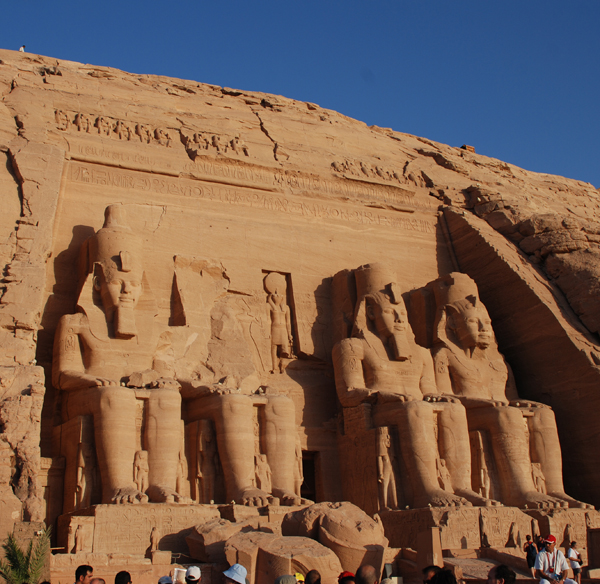Classroom Resources
Teach Through Educational Travel: Abu Simbel, Egypt
Some of the most iconic symbols of ancient Egypt are the pyramids, the Avenue of the Sphinxes at Luxor, King Tutankhamen, and the two temples at Abu Simbel. The two temples are the larger Temple of Ramesses II and the smaller Temple of Nefertari, carved out of rock. As with all history, there’s a great story behind these temples! Built on the Nile by Pharaoh Ramesses II (1301-1213 BC) for himself and his queen, the larger temple features colossal statues of Ramesses in a seated position. The doorway to this temple is lined up such that on two days of the year – February 22 and October 22 – the sun shines all the way to the back, to a statue of Ramesses II. The smaller temple, Nefertari’s Temple of Hathor, is flanked by two large statues of Nefertari (Ramesses’ wife) and two of Ramesses. The temples were forgotten by about the 6th century BCE and buried in the shifting sands until 1813, when Jean-Louis Burckhardt found the top frieze; in 1817, Giovanni Belzoni was able to dig out and enter the complex. Stories say that the complex is named Abu Simbel after a young guide who helped Belzoni with the dig.
Everything changed in 1968. The temples were moved (!) when the Nile was dammed up to create Lake Nasser, courtesy of the Aswan High Dam. The moving of the temples to an artificially created hill 200 feet higher was done in collaboration by the Egyptian government and UNESCO.

- Watch this video about creating Abu Simbel, and then look at some detailed photos. Can you imagine building such an imposing and beautifully carved structure – from rock?
- Read this official website about Abu Simbel’s history (and move) and this UNESCO World Heritage site listing. What strikes you as the most important highlights of Abu Simbel?
- Moving the Temples took almost 5 years, and cost about $42 million dollars! The project involved over 3,000 workers. Check out these awesome videos (long video or short video) on the move. Can you imagine moving such an ancient and important monument? There is no room for error! Discuss some of the problems the engineers may have encountered.
- Check out this 360 panorama of the Abu Simbel Great Temple. What surprised you about seeing this ancient monument (and very close lake)?
Related Articles

The 2024 WorldStrides Student Photo & Video Contest Gallery
Some of the most iconic symbols of ancient Egypt are the pyramids, the Avenue of the Sphinxes at Luxor, King Tutankhamen, and the two temples at Abu Simbel. The two temples are the larger Temple of Ra...

Girl Scouts: Costa Rica Tour
Some of the most iconic symbols of ancient Egypt are the pyramids, the Avenue of the Sphinxes at Luxor, King Tutankhamen, and the two temples at Abu Simbel. The two temples are the larger Temple of Ra...

2024 Mérida Pride Parade
Some of the most iconic symbols of ancient Egypt are the pyramids, the Avenue of the Sphinxes at Luxor, King Tutankhamen, and the two temples at Abu Simbel. The two temples are the larger Temple of Ra...

Rise Up, Take Action: How to Support the LGBTQIA+ Community
Some of the most iconic symbols of ancient Egypt are the pyramids, the Avenue of the Sphinxes at Luxor, King Tutankhamen, and the two temples at Abu Simbel. The two temples are the larger Temple of Ra...


